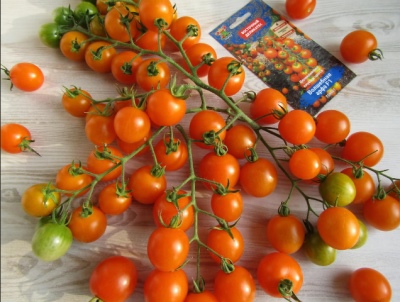
- Authors: Gorshkova N.S., Tereshonkova T.A., Klimenko N.N.
- Year of approval: 2015
- Category: hybrid
- Growth type: indeterminate
- Appointment: fresh consumption, for whole fruit preservation
- Ripening period: early
- Ripening time, days: 90-95
- Growing conditions: for film greenhouses
- Marketability: high
- Leaves: medium, green
For those who like to grow decorative and unusual varieties of tomatoes, the Magic Harp tomatoes will appeal to their taste, since they give bountiful harvests, grow without whims and do not take up much space.
Breeding history
This hybrid type of tomato was bred quite recently, but managed to attract the attention of many summer residents and gardeners who are fond of growing delicious tomatoes in greenhouses. The variety was bred by a group of domestic breeders (Klimenko, Tereshonkova and Gorshkova) less than 10 years ago, and the ornamental tomato was included in the State Register and allowed for cultivation in 2015.
Description of the variety
Carpal hybrid Magic Harp is a tall indeterminate bush, the height of which reaches 180-200 cm. The plant is characterized by moderate thickening, large green leaves and powerful stems, on which fruit clusters are located, which outwardly resembles grapes. Among the mandatory recommendations are pinching and garter to the supports. A plant is formed in 1-2 stems.
The main qualities of the fruit
Cocktail tomatoes have a bright orange color and are incredibly small - on average, 1 tomato weighs 20-25 grams. In the unripe stage, the fruits are light green, sometimes covered with yellow.
The mass of the fruit cluster is 180-200 g. The shape of the tomatoes is round, and the skin is dense and smooth with a pronounced gloss. The variety has good keeping quality. If desired, at the end of the season, you can remove the unripe bunches of tomatoes and let them ripen.
Taste characteristics
Mini tomatoes have a high taste. The pulp of the fruit is fleshy and quite juicy. The taste is dominated by sweetness and fruity notes. The advantage of the variety is not only the visual appeal, but also the versatility of tomatoes. Magic Harp tomatoes can be eaten fresh, canned, processed into sauces and dressings, and salted. In addition, tomatoes contain beta-carotene, an antioxidant, so they are recommended for people suffering from allergic reactions.
Ripening and fruiting
The Magic Harp tomato is an early ripening variety. From the moment the first shoots grow until the fruits ripen, only 90-95 days pass. Ripening of tomatoes occurs amicably, so they are collected in whole bunches. The duration of fruiting is somewhat prolonged, so tomatoes can be harvested until September.
Yield
The yield of this species is excellent. Observing all the rules of agricultural technology, 5.7 kg of fruits can be harvested from 1 m2 per season.
The timing of planting seedlings and planting in the ground
Sowing seeds for seedlings is recommended to be carried out in early March, that is, 60-65 days before the expected date of planting in a permanent place of growth. The seeds are preliminarily disinfected in a solution of potassium permanganate. After sowing, the box is covered with polyethylene to create a greenhouse effect, which will speed up the appearance of the first shoots.
When sprouts appear, the box is placed in a warm and well-lit room. With the appearance of 2-3 real leaves on the bush, a dive is carried out (seating in separate pots). 1-2 weeks before planting in greenhouse soil, it is recommended to harden the bushes by exposing the container with plants to fresh air.
Disembarkation at a permanent place is carried out in calm weather. The best time is the second half of May.

Growing tomato seedlings is an extremely important process, because it largely depends on whether the gardener can harvest at all. All aspects must be taken into account, from seedbed preparation to planting in the ground.
Landing scheme
It is recommended to plant no more than 3-4 bushes of seedlings per 1m2. The optimal planting pattern is 70x50 cm.

Growing and care
Before planting seedlings in the greenhouse, it is recommended to dig up the soil, ensuring air permeability, and also feed with a complex of mineral fertilizers.
Seed crop care requires standard:
- watering with settled water (drip system);
- pinching and garter bushes;
- formation in 1-2 stems, which has a positive effect on the quality of the crop;
- feeding and a set of measures to protect against viruses and diseases.




A plant needs different micronutrients at each stage of growth. All fertilizers can be divided into two groups: mineral and organic. Folk remedies are often used: iodine, yeast, bird droppings, eggshells.
It is important to observe the rate and period of feeding. This also applies to folk remedies and organic fertilizers.
Disease and pest resistance
The vegetable crop has a natural resistance to the standard pathologies of nightshades. The variety is resistant to cladosporium disease, tobacco mosaic virus, fusarium wilt.


Resistant to adverse weather conditions
The plant grows well in greenhouses. The variety does not tolerate drafts and excessive dampness.
Growing regions
In covered greenhouses, the crop is grown in any region of the Russian Federation, Ukraine, Belarus and Moldova.
Review overview
Both experienced farmers and novice gardeners like to grow hybrid tomatoes Magic Harp, since the fruits have excellent taste and are stored for a long time, the plants do not require special care, and give abundant yields. Of the shortcomings, many summer residents indicate the need for regular pinching, as well as excessive vegetation.

























































































